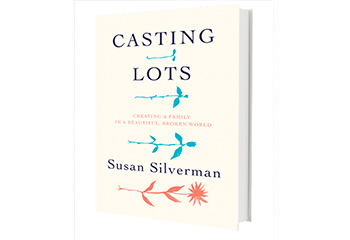Tens of millions of children are growing up as orphans, most of them in impoverished countries of the Third World. Very few of us in the affluent West do anything to help them. In fact, very few of us give them any thought at all.
Rabbi Susan Silverman and her husband Yosef Abramowitz are an exception. Around the beginning of the current century, they adopted two children from Ethiopia, one as an infant and one as a four-year-old. In some circles, the Abramowitz-Silvermans are famous as the butt of a joke on Saturday Night Live by Rabbi Silverman’s comedian sister, Sarah: “My sister Susie got married and they took each other’s names, you know? So now she’s Susan Silverman-Abramowitz. But they’re thinking of shortening it to just ‘Jews.’” But the Abramowitz-Silvermans are also accomplished Jewish educators and writers. A few years ago they co-authored Jewish Family and Life: Traditions, Holidays, and Values for Today’s Parents and Children. Now Rabbi Silverman has written a moving book about her experiences as a child and as a mother, Casting Lots: Creating a Family in a Beautiful, Broken World.
Rabbi Silverman grew up in the United States in an assimilated Jewish home. Before she was a rabbi, she was an activist for many liberal causes, ranging from feminism to vegetarianism to refugee rights, and she continues her activism today. When she began studying to be a Reform rabbi at the Hebrew Union College-Jewish Institute of Religion, she did not know the Hebrew alphabet and had only a shaky knowledge of the cycle of Jewish holidays. Her latest book is filled with quotations from and allusions to classical Jewish texts, some of them well-known and others less so.
For example, in her description of their road to adoption, she repeatedly asserts that the biblical character Serach, the daughter of Asher, was adopted. Serach, who has become something of a darling of Jewish feminists, appears in a list of names in the Torah twice (Genesis 46:27 and Numbers 26:26). Two 13th-century biblical commentators mention a claim found in a fairly obscure medieval midrash collection, Sefer ha-yashar, that Serach, though not precisely adopted, was Asher’s stepdaughter, not daughter.
Other than in the short epilogue to the book, Rabbi Silverman says little about her reasons for adopting. She did not adopt for the most common reason: infertility. She and her husband had two naturally born daughters before they adopted a son. A third daughter was born after their first adoption. She explains only that from the time that she herself was a child, she had always wanted to adopt. Given her activist background, presumably she was motivated by a desire to help at least some of those needy orphans.
The decision to adopt and the process involved are presented in a humorous and self-deprecating style. As she describes it, her decision about what specific child to adopt and from which country seems quirky, either superstitious, mystical or some combination of the two. Perhaps she writes about her momentous decisions light-heartedly so that people who have not taken such selfless steps will not see her as self-righteous.
In the epilogue, Rabbi Silverman is more serious. She lists the various reasons why people object to international adoptions: “Children have a right to their cultural heritage,” “Adoption robs countries of their most precious resource,” “International adoption is corrupt,” “Adoption is merely colonialism wrapped in a humanistic package,” and others. She makes short shrift of these arguments.
She does not deal directly with the long-term effectiveness of cross-racial and cross-national adoptions. Parenting is challenging at the best of times. As Rabbi Silverman puts it: “Raising children is messy, muddled and often loud.” Social scientists (and our experience) teach us that potential problems are more likely in families where the generations do not share a genetic bond. Yes, many adoptions work beautifully, but a recent academic study quoted in Time magazine reports on a persistent concern that “adopted children may be at a heightened risk for mental health or adjustment problems.” Common sense suggests that in a blended family of naturally born children and adopted children, outsider feelings may be exacerbated, especially when the difference between the two sets of children is constantly reinforced by their colour.
Rabbi Silverman is aware of these issues. Even before her first adoption, she confides in her mother, “What if I don’t love an adopted child like I love the girls?” She describes how she and her husband attempted to deal with these tensions sensitively when they adopted their first son. Already as a young child he expressed concerns about being different from his parents and sisters, saying, for example, “I want a brown family. I don’t want to be in this family. I hate this family.” As she puts it, “the unfolding realization of his differences from the rest of his family – his colour, and that he had a tummy-mommy who was different from his mommy – was world-altering.” Creatively, Rabbi Silverman told her young adopted son that while he was (at that point) the only brown member of the family, each member of the family was actually a different colour (tan, olive, white, etc.).
The book was published in 2016, but the last information about the adopted children is from their preschool years, before the family moved to Israel 10 years ago. We are left curious, wondering what happened to them in their teenage years.
Rabbi Silverman’s passion is inspiring, and we readers wish her family the best.
